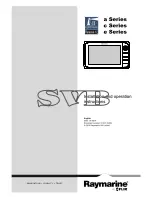
16
eDAQ Potentiostats
operation is required the auxiliary and reference leads (red and
yellow) should be attached to the single ‘counter electrode’.
•
Galvanostat
(Chart and Scope software),
. Connect
the electrodes as described for potentiostat operation, above. Note
especially that the potential signal is provided at I Out,
The current signal is provided at E Out.
•
ZRA
,
zero resistance ammeter, (Chart and Scope software).
Connect the working (green) and auxiliary (red) leads to the two
electrodes (or circuit test points) across which to measure the current,
the current signal is provided at I Out. The auxiliary (red) lead is
earth return. The reference lead (yellow) can be connected to a
reference electrode (or circuit test point) to measure the potential
difference to the auxiliary (and working) leads. The high impedance
potential signal (if used) is supplied at E Out,
.
•
High Z
, high impedance voltmeter (Chart and Scope software).
Connect the working (green) lead to one electrode and the reference
lead (yellow) lead to a reference electrode to measure the potential
difference between the leads. The high impedance potential signal
is delivered at I Out. The auxiliary lead (red) can be connected to a
third electrode (or test point) to provide a ZRA current signal at E
Out,
Please make sure the electrode lead wires are connected appropriately
to your experiment, before operating in any of these modes. In
particular, incorrect placement of leads may damage the reference
electrode, if one is being used.
Signal Display
The current signal is previewed in the scrolling display area. Note that
the signal is not being recorded to hard disk at this stage, and that
when the window is closed the signal trace will be lost.
By using the Dummy or Real modes you can investigate the effect of the
, on the current signal.
You can stop/start the signal scrolling by clicking the Pause/Resume
button .
NOTE.
When using
early models of EA161
Potentiostat (serial
numbers 161-001 to
161-022) as a ZRA you
should connect the
working electrode lead,
and the cable of the
Grounding Connector
(
electrodes (or circuit test
points) across which to
measure the current.
Summary of Contents for Picostat
Page 8: ...4 eDAQ Potentiostats ...
Page 28: ...24 eDAQ Potentiostats ...
Page 44: ...40 eDAQ Potentiostats ...
Page 64: ...60 eDAQ Potentiostats ...
Page 104: ...100 eDAQ Potentiostats ...
Page 112: ...108 eDAQ Potentiostats ...
















































